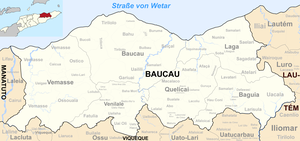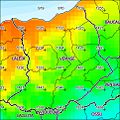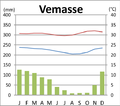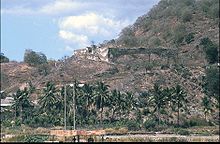Vemasse (administrative office)
| Administrative office of Vemasse | ||
|
|
||
| Administrative headquarters | Vemasse | |
| surface | 358.47 km² | |
| population | 9,643 (2015) | |
| Sucos | Population (2015) | |
| Caicua | 77 | |
| Loilubo | 1,282 | |
| Ossouala | 1,067 | |
| Ostico | 1,206 | |
| Uaigae | 758 | |
| Uato-Lari | 711 | |
| Vemasse | 4,542 | |
| Overview map | ||

|
||
Vemasse ( Vemassi, Vemase, Vermasse, Vemassey, Vemace ) is an East Timorese administrative office ( Portuguese Posto Administrativo ) in the municipality of Baucau . The administrative seat is in Vemasse . The name “Vemasse” is derived from “Wemasi” , the Galoli word for “salty water”. An old name for the region is Ade .
geography
Until 2014, the administrative offices were still referred to as sub-districts . Before the 2015 regional reform, Hato-Udo had an area of 374.62 km². Now there are 358.47 km².
The administrative office occupies the west of the municipality of Baucau. In the east it borders on the administrative offices of Baucau and Venilale , in the south on the municipality of Viqueque with the administrative offices of Lacluta , Viqueque and Ossu and in the west on the municipality of Manatuto with the administrative office of Laleia . In the east flows the Manuleiden , in the west and south the river Vemasse and its tributaries and in the southwest flow Mori and Bina , tributaries of the Laleia .
Parts of Vemasse belong to the Important Bird Area Monte Mundo Perdido , with a number of rare bird species, but also other animals and rare orchids.
Vemasse is divided into seven sucos : Caicua , Loilubo , Ossouala ( Ossoala ), Ostico , Uaigae , Uato-Lari ( Uatu-Lari ) and Vemasse ( Vemase ).
- Climate data
Residents
9,643 people live in the administrative office (2015), of which 4,860 are men and 4,783 are women. The population density is 26.9 inhabitants / km². The largest language group are the speakers of the Waimaha . Galoli is also spoken here . The average age is 18.4 years (2010, 2004: 18.3 years).
history
The realm of Vemasse
Much of the municipality of Baucau was formerly part of the empire of Vemasse or was under its influence. The empire used to be called Ade . It was tributary to the kingdom of Luca for a long time , but was able to break away in the second half of the 17th century. They turned to traders from Makassar and even set the Dutch flag . A Topasse fleet ended this alliance and conquered Ade, making it part of Portuguese sovereignty again.
In September 1731, the Varella Empire rebelled against the Portuguese . Vemasse supported the rebels. A peace treaty was signed on March 16, 1732. In 1752 there was already a Catholic church in Vemasse.
According to oral tradition, the members of the ruling family Topasse were from Larantuka on the eastern tip of the island of Flores . They came to East Timor via Oecussi in the 18th century, in the expectation that the Portuguese would found their new colonial capital here on Timor after they had been expelled from Lifau in 1769 . In the same year, however, Dili was expanded to become the new seat of the governor. Dom Felipe de Freitas Soares , the ruler of Vemasse, was one of 42 Liurais who swore their allegiance shortly afterwards in Dili Portugal.
In 1803 Dom Felipe de Freitas , the illegitimate son of the Liurais, was exiled to Goa by Governor João Vicente Soares da Veiga (1803 to 1807) as the first Timorese after he had led a rebellion against the Portuguese. Until now this punishment had not been common.
Finally, the leader of the Topasse, the Galoli- speaking Dom Domingos da Costa Freitas (also Gali Kai ) was made Dato-hei ( Timorese prince ) of Vemasse by the Portuguese .
In 1859 Dom Domingos de Freitas Soares led a minor revolt against the Portuguese, but it was quickly suppressed. Dom Domingos was exiled to Lisbon that same year . As early as the spring of 1861, Vemasse supported the colonial power with fighters against the uprising in Laclo .
Vermasses' alliance with the Portuguese finally ended with the rebellion of 1867 . In August the people of Vemasse rose and besieged Lalcia . Governor Texeira da Silva ended the siege and put down the uprising with the help of allied Liurais ( Timorese petty kings ). The Liurai of Vemasse was replaced by his deputy, the Dato-hei , who swore an oath of alliance and promised peaceful relations with the neighbors. In 1869, Gali Kais' son, Dom Francisco da Costa Freitas, was appointed Liurai of Baucau, while his son-in-law Tomas de Costa Soares became Dato-hei of Letemumo .
In 1882 there was fighting between Vemasse and Laleia , for which the commander of the military headquarters was held responsible.
Close relations existed with the island of Kisar, which is dominated by the Netherlands . They visited each other regularly, traded in gold and water buffalo and the Raja of Vonreli on Kisar paid a tribute to the Liurai of Vemasse. It was not until the end of the 19th century that the Portuguese governor of Timor, José Celestino da Silva (1894 to 1908) , stopped all contact, as the Raja refused to convert from Protestantism to Catholicism. But already 15 years later the contacts were renewed when the Raja von Kisar docked with a fleet of 20 small ships on the beach of Baucau.
After the colonial era
After rumors arose that the Indonesian invaders had murdered ten civilians in Karabela on December 11, 1975 , the population from Vemasse first fled to Mount Lame , on the southern edge of the town, where simple barracks were built. There they were joined by residents of Karabela and Bucoli . The population was able to return to their arable land for harvest as the Indonesians had not left any occupation troops in Vemasse. So the refugees could get enough food, but in the middle of March 1976 the Indonesians attacked the refugee camp with bazookas and mortars and destroyed both the huts and the food store. The residents fled along the Rio Vemasse eight kilometers further south, to Uaigae, where they again planted gardens for self-sufficiency. But as the fighting drew closer, they had to flee again until they finally found refuge again in Uai-Mori (today Suco Bibileo , 20 km south of Vemasse), under the protection of the FRETILIN . A base de apoio was created here, a base of resistance. Together with refugees from Dili, Viqueque and other parts of the country, they lived here for two years. Over time, food shortages grew as more and more people arrived. In 1978, Uai-Mori was also attacked by Indonesian forces. Most of the residents fled, some were captured by the Indonesians and taken to the Bucoli assembly camp.
In Lobito , in Suco Vemasse, the East Timorese freedom fighter Aquiles Freitas Soares and some of his supporters were executed by FRETILIN. Here was a resistance base ( bases de apoio ).
At the end of 1979 there was an Indonesian camp for East Timorese in the town of Vemasse, who were to be relocated by the occupiers for better control.
In 2014, five sucos from Vemasse had food shortages after the harvest, which is why the suco bosses and the administrator of the sub-district asked for humanitarian aid. Trade Minister António da Conceição agreed with a trader to supply rice, which would be sold to the local population at a low price. There was a lack of data on those in need for a free distribution. Although the government had deposited the purchase price for the rice in an account, according to Conceição, the administrator sold the rice at a higher price than agreed. The administrator was then arrested. Conceição is accused of participating in the business, which is why he wants to face a hearing before the district court of Baucau.
In November 2005, two East Timorese police were killed by a bomb dropped on their vehicle in Vemasse.
politics

The administrator of the administrative office is appointed by the central government in Dili. In 2013 it was Tomás Freitas , in 2015 Sebastião Filomeno Correia .
economy
53% of households grow rice, 47% coconuts, 48% corn, 37% cassava, 19% coffee and 28% vegetables. Large quantities of manganese can be found in the administrative office . There is also gold, silver and copper.
Sons and daughters
Carlos Filipe Ximenes Belo , Nobel Peace Prize Laureate and former Bishop of Dili, was born in the village of Wailakama near Vemasse .
partnership
Since May 2009 the administrative office of Vemasse has had a partnership with Monash City in Australia .
Web links
- Friends of Vemasse : partnership with Monash City
- Information on the Kingdom of Vemasse ( Memento of September 28, 2007 in the Internet Archive )
Individual evidence
- ↑ a b c d e Direcção-Geral de Estatística : Results of the 2015 census , accessed on November 23, 2016.
- ↑ Jornal da República : Diploma Ministerial no 24/2014 de 24 de Julho - Orgânica dos Postos Administrativos ( Memento of March 4, 2016 in the Internet Archive )
- ↑ Geoffrey Hull : The placenames of East Timor , in: Placenames Australia (ANPS): Newsletter of the Australian National Placenames Survey, June 2006, pp. 6 & 7, ( Memento of the original from February 14, 2017 in the Internet Archive ) Info: The archive link was inserted automatically and has not yet been checked. Please check the original and archive link according to the instructions and then remove this notice. accessed on September 28, 2014.
- ↑ a b Hans Hägerdal: Lords of the Land, Lords of the Sea; Conflict and Adaptation in Early Colonial Timor, 1600–1800 (2012).
- ↑ a b Direcção Nacional de Estatística: 2010 Census Wall Chart (English) ( Memento of the original from August 12, 2011 in the Internet Archive ) Info: The archive link was automatically inserted and not yet checked. Please check the original and archive link according to the instructions and then remove this notice. (PDF; 2.5 MB)
- ^ Timor-Leste GIS-Portal ( Memento from June 30, 2007 in the Internet Archive )
- ↑ a b c Seeds of Life
- ↑ Direcção Nacional de Estatística: Census of Population and Housing Atlas 2004 ( Memento of November 13, 2012 in the Internet Archive ) (PDF; 14 MB)
- ↑ Hans Hägerdal: Rebellions or factionalism? Timorese forms of resistance in an early colonial context, 1650-1769
- ↑ Susana Barnes, Hans Hägerdal, Lisa Palmer: An East Timorese Domain - Luca from Central and Peripheral Perspectives , p. 335, 2017, doi: 10.1163 / 22134379-17302020 , accessed on November 22, 2017.
- ↑ History of Timor - Technical University of Lisbon ( Memento of the original from March 24, 2009 in the Internet Archive ) Info: The archive link has been inserted automatically and has not yet been checked. Please check the original and archive link according to the instructions and then remove this notice. (PDF; 824 kB)
- ↑ a b c "Chapter 7.3 Forced Displacement and Famine" ( Memento of the original from November 28, 2015 in the Internet Archive ) Info: The archive link was inserted automatically and has not yet been checked. Please check the original and archive link according to the instructions and then remove this notice. (PDF; 1.3 MB) from the "Chega!" Report by CAVR (English)
- ↑ "Chapter 7.2 Unlawful Killings and Enforced Disappearances" ( Memento of the original from March 25, 2016 in the Internet Archive ) Info: The archive link was inserted automatically and has not yet been checked. Please check the original and archive link according to the instructions and then remove this notice. (PDF; 2.5 MB) from the "Chega!" Report by CAVR (English)
- ↑ Timor Agora: Parlamento timorense levanta imunidade a deputado para responder em tribunal , November 13, 2018 , accessed on November 14, 2018.
- ↑ Ministério da Administração Estatal: Administração Municipal ( Memento of the original from June 1, 2016 in the Internet Archive ) Info: The archive link has been inserted automatically and has not yet been checked. Please check the original and archive link according to the instructions and then remove this notice.
- ↑ Direcção Nacional de Estatística: Suco Report Volume 4 (English) ( Memento of the original from April 9, 2015 in the Internet Archive ) Info: The archive link was inserted automatically and has not yet been checked. Please check the original and archive link according to the instructions and then remove this notice. (PDF; 9.8 MB)
- ↑ Ministry of State Administration & Territorial Management, Timor-Leste: Baucau District profile ( Memento of the original from March 28, 2009 in the Internet Archive ) Info: The archive link was automatically inserted and not yet checked. Please check the original and archive link according to the instructions and then remove this notice. (PDF; 276 kB)
Coordinates: 8 ° 31 ' S , 126 ° 13' E









